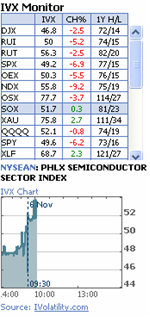
IVX
Encyclopedia

IVX is a volatility
Volatility (finance)
In finance, volatility is a measure for variation of price of a financial instrument over time. Historic volatility is derived from time series of past market prices...
index providing an intraday, VIX
VIX
VIX is the ticker symbol for the Chicago Board Options Exchange Market Volatility Index, a popular measure of the implied volatility of S&P 500 index options. Often referred to as the fear index or the fear gauge, it represents one measure of the market's expectation of stock market volatility over...
-like measure for any of US securities and exchange traded instruments. IVX is the abbreviation of Implied Volatility Index and is a popular measure of the implied volatility
Implied volatility
In financial mathematics, the implied volatility of an option contract is the volatility of the price of the underlying security that is implied by the market price of the option based on an option pricing model. In other words, it is the volatility that, when used in a particular pricing model,...
of each individual stock. IVX represents the cost level of the options for a particular security and comparing to its historical levels one can see whether IVX is high or low and thus whether options are more expensive or cheaper. IVX values can be compared for the stocks within one industry to find names which significantly differ from what is observed in overall sector.
Specifications
IVX is an expected stock volatility over a future period. It is derived from current option prices and it is available for any optionable securityTo calculate this index they use a proprietary weighting technique factoring the Delta and Vega of each option participating in its calculations. In total, 8 ATM options (4 calls and 4 puts) are used within each expiration to calculate the Call, Put and Mean Implied Volatility of each stock. This IV Index is normalized to fixed tenors (30, 60, 90, 120, 150, 180, 360, 720 days) using a linear interpolation by the variance (IV2t)
IVX and VIX have similar nature, despite some diversities in the methodology and calculation. VIX (introduced by CBOE in 2003) is counted as an option prices’ weighted average, using all available range of strikes, thus it is independent of the model used to derive implied volatilities. This technique works with a thick grid of actively traded strikes (i.e. S&P 500
S&P 500
The S&P 500 is a free-float capitalization-weighted index published since 1957 of the prices of 500 large-cap common stocks actively traded in the United States. The stocks included in the S&P 500 are those of large publicly held companies that trade on either of the two largest American stock...
and other indices), but not for the majority of optionable stocks. IVX allows calculating this measure for each individual stock, not just for the market in general.
Interpretation
IVX is calculated in the following way: (an example based on "IVX Call 30") suppose today is 04/05/2004, and there are 12 days till front month (April) expiry — and 47 days till next month expiry (May). Options with these two expiries will be used for IV Index calculation of term 30 — as they are 2 expiries closest to 30-day virtual expiration.First, 4 April Call options contracts with strikes nearest to current stock price (spot) are selected—they are used to calculate IV Index for April. "IVX Call April" is their weighted average, where weighting is by Vega (option price sensitivity to a change in implied volatility). Some of these options, however, can be considered "bad" and filtered out of further calculations. For example, options with expiry less than 1 week from now are always discarded. The other check is that so-called put-call parity relation should not vary significantly. This means that implied volatility values of Call and Put option in the pair are sufficiently close. Briefly, the filtering algorithm tries to eliminate suspicious option contract to make sure that the resulting IV Index figure is relevant.
In the very same way, the IV Index for May expiry is calculated, "IVX May". Now, interpolation is performed between these two values to get "IVX Call 30"; interpolation is linear by variance, that is,

This particular interpolation
Interpolation
In the mathematical field of numerical analysis, interpolation is a method of constructing new data points within the range of a discrete set of known data points....
is commonly used when dealing with volatilities.
History
Implied Volatility Index was introduced in 1998 and it is a registered trade mark ofIVolatility.com.
- 1998 – Implied Volatility Index measure was introduced for 30 day term for US equity markets
- 2000 – Additional IV Index terms were added: 60, 90, 120, 150, 180, 360, 720
- 2002 – Coverage of IV Index is expanded to European Markets
- 2003 – Methodology revision: original time interpolation by square root of time is replaced with more accurate interpolation by variance.
- 2004 – Methodology revision: additional filtering by call-put parity is added
- 2005 – Coverage of IV Index is expanded to US future markets: index futures, agriculture, metals, FX, etc
- 2006 – IV Index becomes available intra day for US equity markets
- 2007 – IV Index is registered under the trademark ‘IVX’
- 2008 – IVX becomes available intraday for US futures markets
Criticism
Being an excellent measure of an averaged implied volatility of the stock, IVX, however, sometimes can not be calculated for the stocks with the illiquid options that have no volume traded and huge spread in prices. This is because none of the option models will produce good volatility measure using the options with unreliable prices.Many commented in the past on availability of IVX only as an end-of-the-day measure; however, this changed last years, and now IVX is available on an intraday basis.

